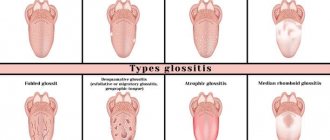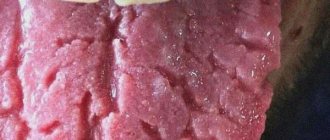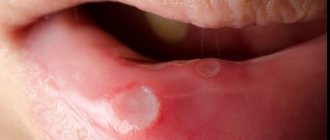Reasons for appearance
Ulcerations and abscesses are inflammations of an erosive nature, in which the patient constantly feels itching and pain.
Sores under the tongue may indicate dental problems and cancer.
The dentist and specialists will help determine the cause. Treatment includes antibiotics, antiseptics, antiviral and antiherpetic drugs.
Ulcers and ulcers in the mouth can occur sporadically as a result of failure to maintain proper oral hygiene. More often they are a sign of a serious illness.
There are several reasons for the appearance of sores in the sublingual area.
Leukoplakia
This is an inflammatory process on the mucous membrane, leading to its keratinization.
The disease is dangerous because it can develop into cancer. Ulcers under the tongue at the initial stage of the disease do not bother the patient. Over time, they begin to become inflamed, grow, and interfere with talking and eating. Oral leukoplakia is accompanied by a number of specific symptoms:
- white coating on the tongue;
- white-gray formations;
- burning sensation and pain in the affected area.
The causes of the appearance and development of the disease have not been established for certain. Erosive ulcers in the mouth and under the tongue, bleeding, proliferation of affected areas, the appearance of edema and the spread of inflammation to the lips, palate, tongue - a sign of the transition of leukoplakia to the malignant stage.
If the appearance of an ulcer under the tongue is accompanied by abdominal pain, sudden weight loss, or diarrhea, then you need to consult not only a dentist, but also a gastroenterologist.
Such symptoms may be a sign of inflammatory diseases of the gastrointestinal tract, celiac disease.
Dentist
Novikova Olga Alexandrovna
8 years of experience
Stomatitis
The main cause of stomatitis is failure to comply with hygiene rules, as a result of which pathogenic microbes actively multiply in the mouth. The causes of sublingual stomatitis are previous acute respiratory viral infections, influenza, and decreased immunity.
Stomatitis is often a chronic disease; sores and abscesses under the tongue appear only during the period of exacerbation of the disease. Ulcers under the tongue are a sure sign of aphthous stomatitis, which takes a long time to treat.
Abscesses and sores can occur one by one, and sometimes rashes can be seen. Aphthous ulcers are painful, but with proper treatment you can get rid of the sore in 7-10 days.
With herpetic stomatitis, the lower palate and sublingual area are strewn with small blisters filled with grayish liquid. The inflammatory process lasts 10-14 days.
Stomatitis is characterized by the appearance of 2-3 small ulcers-wounds covered with a white or yellowish film.
Glossitis
The advanced form of glossitis is dangerous due to the occurrence of an abscess and inflammation of the neck and chin. Redness, cracks and ulcers can occur due to a lack of vitamin B.
Concomitant somatic diseases
The appearance of abscesses and sores may be a sign of the presence of somatic diseases in the body: syphilis, tuberculosis, HIV infection, allergies. In this case, treatment is aimed at eliminating the underlying disease.
Oncological diseases
With tongue cancer, ulcers can be located both on the surface of the organ and under it. A non-healing abscess in the oral cavity is the main complaint of patients.
Injuries
Damage to the oral mucosa, tongue biting, malocclusion, trauma due to poor prosthetics, as well as chemical or thermal burns can cause sores.
As a rule, they do not require treatment and do not lead to serious inflammation in the oral cavity. In some cases, wounds and ulcers under the tongue can cause infection to appear and spread.
Causes of pain under the tongue
- Allergic reactions cause tissue swelling and pain.
- Harmful microorganisms that appear in the mouth during a sore throat cause acute inflammation. Often, it affects the floor of the mouth.
- Mechanical injuries from a bruise or a fall damage blood vessels, nerves, and soft tissues. Vessels may rupture, which will lead to the accumulation of blood between the muscle fibers.
- Some untreated diseases lead to phlegmon, inflammation with pus inside. In most cases, phlegmon appears under the tongue.
- Ordinary caries, if left untreated, causes inflammation that reaches the sublingual area.
- There are many ducts in the salivary gland, and if an infection gets into it, then through these ducts it can easily enter the gland tissue.
- Injury to the frenulum of the tongue. In people with a congenital short frenulum, injuries occur more often. Even a normal conversation can cause a breakup. However, people with a normal frenulum size also suffer. Inflammatory diseases and allergic reactions often lead to injury, leading to swelling of the tongue and the appearance of ulcers. But also improper oral hygiene leads to damage to the frenulum - the so-called dangerous brushing.
Some people have asymmetry of the hyoid bone from birth, and sometimes this anomaly is formed due to injury. Asymmetry prevents the organs of the floor of the mouth from functioning properly.
Symptoms and signs
The most common cause of sores and ulcers is sublingual stomatitis, which is characterized by the following symptoms:
- the appearance of a whitish or yellowish coating on the tongue;
- swelling;
- ulcers and abscesses in the sublingual area.
In especially severe cases, ulcerations heal poorly, fester, and subsequently leave a scar.
With herpetiform stomatitis, the ulcers are located at the bottom of the tongue. In appearance, they resemble herpes - small blisters filled with liquid.
With tuberculosis of the oral cavity, the sores initially look like small tubercles, the ulcers are round, their edges are undermined. Often the formations may bleed. Over time, they become very painful, the patient's condition worsens sharply, and pain occurs when eating and talking.
Why can our articles be trusted?
We make health information clear, accessible and relevant.
- All articles are checked by practicing doctors.
- We take scientific literature and the latest research as a basis.
- We publish detailed articles that answer all questions.
With tongue cancer, the patient observes lumps. Mouth ulcers are a sign of metastatic disease. They can reach from 1 to 4 cm. The color of the affected area can vary from dark red to dark gray or yellow.
Tongue cyst is a rare disease. A small, painful white growth forms under the tongue. The patient has difficulty breathing and swallowing.
Stomatitis: features of the disease
Stomatitis is a disease related to dental pathologies in which inflammation of the oral mucosa occurs. Infection of the tongue with stomatitis in adults is also called “glossitis.”
The inflammatory process affects the mucous membrane and causes severe symptoms:
- redness and swelling of the tongue;
- formation of white plaque;
- severe pain;
- the formation of many small blisters and ulcers.
Due to severe sensitivity and soreness of the tongue, the patient cannot eat food, fever, insomnia and irritability are possible.
Stomatitis under the tongue in adults, as in other parts of the oral cavity, is classified into two types.
- Aphthous. A form of inflammation in which the tongue becomes covered with papules and ulcers that turn into erosions (aphthae).
- Herpetic. The inflammatory process is manifested by swelling and redness of the tongue. Small bubbles are localized in groups.
Prosthetic stomatitis and ulcerative-necrotic form of pathology are extremely rare.
Without treatment, the signs of stomatitis completely disappear, but this does not mean that the patient is cured of the pathology. The inflammatory process becomes chronic and when the immune system is weakened or exposed to an irritant, a relapse occurs.
Treatment
You should consult a doctor even if the formation does not bother you or hurt. Therapy should be aimed at combating factors that provoke the appearance of abscesses, as well as strengthening the immune system. In most cases, sores and ulcers disappear after using local remedies: ointments, sprays. In more serious cases, specific therapy is prescribed.
Self-medication is dangerous with complications!
Attention
Despite the fact that our articles are based on trusted sources and have been tested by practicing doctors, the same symptoms can be signs of different diseases, and the disease may not proceed according to the textbook.
Pros of seeing a doctor:
- Only a specialist will prescribe suitable medications.
- Recovery will be easier and faster.
- The doctor will monitor the course of the disease and help avoid complications.
find a doctor
Do not try to treat yourself - consult a specialist.
The doctor prescribes treatment depending on the cause of the ulceration.
If the sores under the tongue are the result of mechanical action, then treatment with hydrogen peroxide, brilliant green, propolis, and soda solution is prescribed.
Ulcers and sores are painful, so the specialist prescribes painkillers based on corticosteroids. Sores and ulcers under the tongue that are caused by herpes can be cured with the help of antiviral drugs. Candidal stomatitis is treated with antibiotics. In addition, the patient is prescribed vitamin C. Antiallergic medications are often recommended.
Ulcers caused by HIV infection are treated with drugs to restore the immune system.
There is a list of universal remedies that combat the appearance of sores in the mouth. These include:
- iodine and brilliant green;
- drugs based on lidocaine;
- Cholesal;
- mouthwash ;
- churacilin.
Ulcers under the tongue caused by tuberculosis are treated with chemotherapy. Syphilitic abscesses are treated with medications.
Drugs with anti-inflammatory properties will help relieve swelling and discomfort.
Before starting treatment, it is recommended to consult a specialist.
Treatment and removal methods
The treatment regimen is drawn up depending on what factors caused the anomaly. But treatment is necessary so that the acute stage of the disease does not develop into the chronic phase. If this happens, the exacerbation will recur from time to time. This form of the disease is more difficult to treat. If necessary, laser treatment of gums should be carried out on time. A healthy oral cavity is the key to the overall well-being of the body.
- The doctor selects medications based on the underlying pathology. The initial manifestations of the disease are successfully eliminated with medications and local applications. According to indications, medications are recommended that stimulate saliva production. This may be Galantamine, Pilocarpine, Potassium Iodide. To maintain general condition, the doctor selects means to stimulate the immune system.
- Serious blockage of the salivary glands is eliminated by mechanical cleaning of the ducts. Today, sialoscopy, a minimally invasive procedure for grinding mineral deposits, is widely used.
- Purulent papules are opened, after which the exudate is removed. Surgical technologies such as galvanocaustics, electrocoagulation, cryodestruction, laser beams, and radio waves are used.
- Sanitation of the oral cavity to accelerate the regeneration of damaged tissue includes rinsing with Chlorhexidine, Furacilin, Rotokan, Miramistin.
To prevent pathology, you need to regularly carry out hygiene procedures with a brush and toothpaste. In addition, floss and irrigator should be used. It is necessary to visit the dentist every six months, and other doctors when the initial symptoms of the disease appear.
Prevention
To avoid consequences, you should regularly visit a dentist, observe the rules of oral hygiene, do fluorography in a timely manner, avoid mechanical and chemical injuries to the tongue, avoid alcohol and smoking, and adhere to a diet.
Nutrition should be balanced, rich in microelements and B vitamins. A mandatory condition for maintaining health is taking medications that stimulate the body’s protective functions.
Sores under the tongue can be a signal of a serious disease, therefore, if discomfort and pain appear in the oral cavity, as well as in the presence of lumps and small wounds, the patient should consult a doctor in order to begin timely treatment and avoid negative consequences.
How is the treatment carried out?
Treatment for stomatitis is comprehensive.
- Anesthesia. To eliminate pain, the dentist may prescribe topical medications containing lidocaine or analgesics.
- Antiviral therapy. If the disease is caused by a herpes virus, the doctor prescribes antiviral drugs of the appropriate group of effects.
- Antibacterial therapy. In case of bacterial stomatitis, local treatment of the oral cavity with antiseptic solutions and dental ointments with antibacterial action is mandatory.
- Antifungal therapy. Stomatitis can be the result of fungal activity in the mouth. This form is more common in children, but is not excluded in adults. The specialist prescribes the patient a strict regimen of antifungal drugs.
- Anti-inflammatory therapy. It is carried out in cases of severe inflammation. The dentist recommends taking anti-inflammatory systemic drugs that have a targeted effect depending on the pathogen or cause of tongue stomatitis.
- Diet. Patients with stomatitis are prescribed a diet that excludes foods that can aggravate irritation of the mucous membrane and tongue. So dentists recommend avoiding hot, spicy, sour and salty foods. Smoking and drinking alcohol should be avoided.
Together with the treatment of stomatitis, treatment of diseases of the respiratory system, gastrointestinal tract, inflammation of the gums, caries, etc. can be carried out.










